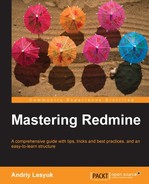I can't think about any better way to demonstrate the workflow configuration than reviewing some real-life practical example. As Kanban Agile methodology is most popular, nowadays, let's see how to configure the workflow to satisfy Kanban task rotation practices.
Kanban does not have any strict requirements to the board and column names, so here we'll use the following issue statuses, which should correspond to real-life column names on the Kanban board (except the New status, which should be set on creation, and means is to be reviewed):

Assuming there is only one tracker and three roles: "Project manager", who reviews new issues and closes ready ones, "Developer" and "Tester". The following minimal settings should be applied in Redmine:
|
NEW |
ACCEPTED |
IN PROGRESS |
TESTIN |
PASSED |
DONE | |
|
Project manager | ||||||
|
NEW |
√ |
√ | ||||
|
PASSED |
√ | |||||
|
Developer | ||||||
|
ACCEPTED |
√ | |||||
|
IN PROGRESS |
√ | |||||
|
Tester | ||||||
|
TESTING |
√ |
√ |
Of course, this is a very basic example, but you can use it as the starting point.
Tip
Redmine Backlogs plugin
If you are using Agile development in your team, you may find the Backlogs plugin useful. Go to http://www.redminebacklogs.net.
